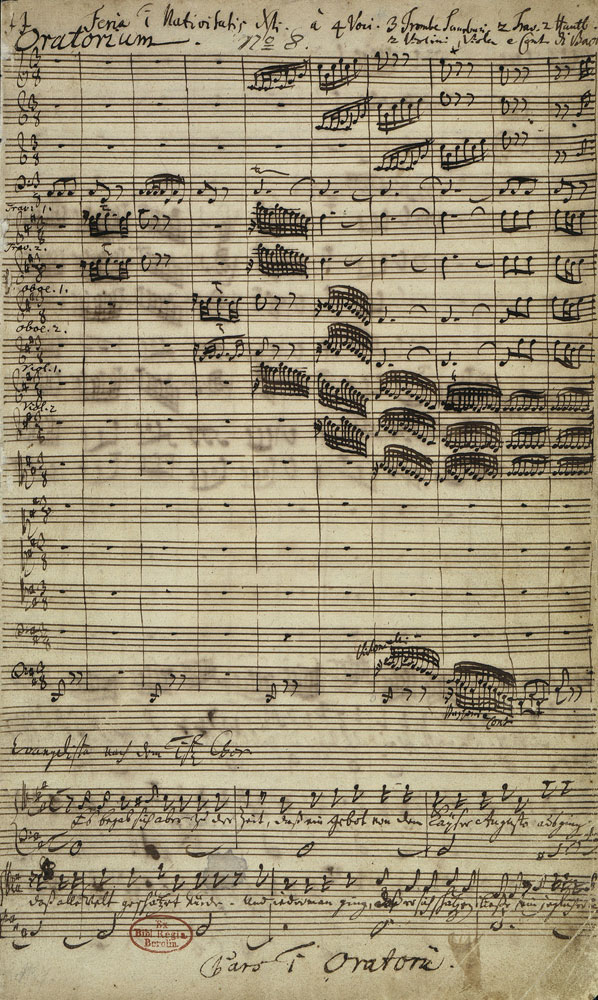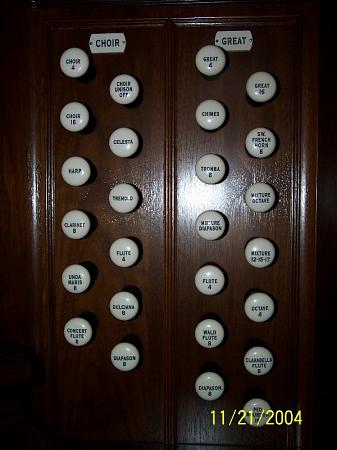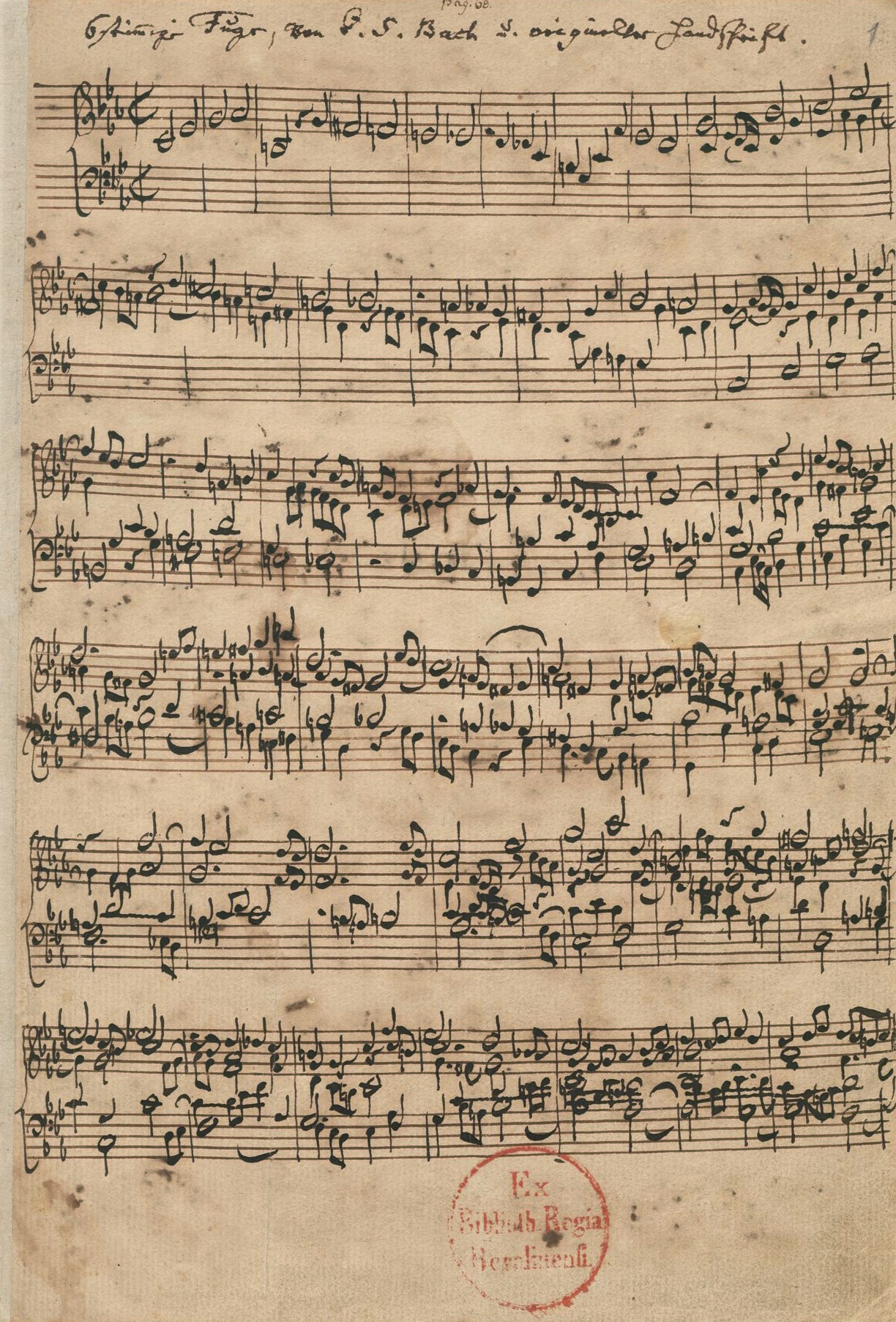|
BWV 197
(God is our confidence), BWV 197.2 (formerly BWV 197), is a church cantata by Johann Sebastian Bach. History and text In 1728 in Leipzig, Bach composed a Christmas cantata, (Glory be to God in the Highest), which he revised in 1736–37 into this wedding cantata. Movement 5 is a chorale stanza by Martin Luther, the final movement is by Georg Neumark; the rest of the poetry is anonymous. Scoring and structure The cantata is scored for three vocal soloists (soprano, alto, and bass), a four-part choir, three trumpets, timpani, two oboes, two oboes d'amore, bassoon, two violins, viola, and basso continuo. The work's ten movements are divided into two parts of five movements each, to be performed before and after the wedding sermon. ;Part 1 #Chorus: #Recitative (bass): #Aria (alto): #Recitative (bass): #Chorale: ;Part 2 #Aria (bass): #Recitative (soprano): #Aria (soprano): #Recitative (bass): #Chorale: Music The opening movement is a chorus in da capo for ... [...More Info...] [...Related Items...] OR: [Wikipedia] [Google] [Baidu] |
Bach Digital
Bach Digital (German: ), developed by the Bach Archive in Leipzig, is an online database which gives access to information on compositions by Johann Sebastian Bach and members of his family. Early manuscripts of such compositions are a major focus of the website, which provides access to high-resolution digitized versions of many of these. Scholarship on manuscripts and versions of compositions is summarized on separate pages, with references to scholarly sources and editions. The database portal has been online since 2010. History In 2000, two years after Uwe Wolf had suggested the possibility of supporting the publication of the New Bach Edition (NBE) with digital media, a project named Bach Digital started as an initiative of the Internationale Bachakademie Stuttgart, but without direct involvement of the then editor of the NBE, the Johann Sebastian Bach Institute in Göttingen. After four years the project remained unconvincing: it lagged behind technically and came to ... [...More Info...] [...Related Items...] OR: [Wikipedia] [Google] [Baidu] |
Violin
The violin, sometimes referred to as a fiddle, is a wooden chordophone, and is the smallest, and thus highest-pitched instrument (soprano) in regular use in the violin family. Smaller violin-type instruments exist, including the violino piccolo and the pochette (musical instrument), pochette, but these are virtually unused. Most violins have a hollow wooden body, and commonly have four strings (music), strings (sometimes five-string violin, five), usually tuned in perfect fifths with notes G3, D4, A4, E5, and are most commonly played by drawing a bow (music), bow across the strings. The violin can also be played by plucking the strings with the fingers (pizzicato) and, in specialized cases, by striking the strings with the wooden side of the bow (col legno). Violins are important instruments in a wide variety of musical genres. They are most prominent in the Western classical music, Western classical tradition, both in ensembles (from chamber music to orchestras) and as solo ... [...More Info...] [...Related Items...] OR: [Wikipedia] [Google] [Baidu] |
Nikolaus Harnoncourt
Johann Nikolaus Harnoncourt (6 December 1929 – 5 March 2016) was an Austrian conductor, known for his historically informed performances. He specialized in music of the Baroque period, but later extended his repertoire to include Classical and early Romantic works. Among his best known recordings are those of Bach, whose 193 cantatas he recorded with Gustav Leonhardt. Starting out as a classical cellist, he founded his own period instrument ensemble, Concentus Musicus Wien, in 1953, and became a pioneer of the Early Music movement. Around 1970, Harnoncourt began conducting opera and concert performances, soon leading international symphony orchestras, and appearing at leading concert halls, operatic venues and festivals. In 2001 and 2003, he conducted the Vienna New Year's Concert. Harnoncourt was also the author of several books, mostly on subjects of performance history and musical aesthetics. Early life Johann Nikolaus Harnoncourt was born as an Austrian citizen i ... [...More Info...] [...Related Items...] OR: [Wikipedia] [Google] [Baidu] |
Concentus Musicus Wien
Concentus Musicus Wien (CMW) is an Austrian baroque music ensemble based in Vienna. The CMW is recognized as a pioneer of the period-instrument performance movement. History Nikolaus Harnoncourt and Alice Harnoncourt co-founded the CMW in 1953, along with several musicians from the Vienna Symphony Orchestra. The CMW did research and rehearsal for 4 years before their first official concert; although the ensemble made its 'unofficial' debut at the Konzerthaus, Vienna in 1954 with a production of Claudio Monteverdi's '' Orfeo'', the CMW's first public concert was in May 1957 at the Schwarzenberg Palace in Vienna. The CMW gave a regular concert series at the Schwarzenberg Palace from 1958 to 1962. The CMW made its formal debut in the ''Mozart-Saal'' of the Vienna ''Konzerthaus'' in February 1962, and performed concerts regularly there until 1971. The CMW staged its first opera at the 1971 Wiener Festwochen with Monteverdi's '' Il ritorno d'Ulisse in patria''. The CMW's first ... [...More Info...] [...Related Items...] OR: [Wikipedia] [Google] [Baidu] |
Wiener Sängerknaben
The Vienna Boys' Choir () is a choir of boy sopranos and altos based in Vienna, Austria. It is one of the best known boys' choirs in the world. The boys are selected mainly from Austria, but also from many other countries. The choir is a private, non-profit organization. There are approximately 100 choristers between the ages of nine and fourteen. The boys are divided into four touring choirs, named after Austrian composers Bruckner, Haydn, Mozart and Schubert, which combined perform about 300 concerts each year before almost 500,000 people. Each group tours for about nine to eleven weeks. Some pieces include "Good Morning" and "Merry Christmas from Vienna Boys". Early history The choir is the modern-day descendant of the boys' choirs of the Viennese Court, dating back to the late Middle Ages. The Wiener Hofmusikkapelle was established by a letter from Emperor Maximilian I of the Holy Roman Empire on 30 June 1498, instructing court officials to employ a singing master, two b ... [...More Info...] [...Related Items...] OR: [Wikipedia] [Google] [Baidu] |
Max Van Egmond
Max van Egmond (born 1 February 1936 in Semarang) is a Dutch bass and baritone singer. He has focused on oratorio and Lied and is known for singing works of Johann Sebastian Bach. He was one of the pioneers of historically informed performance of Baroque and Renaissance music. Career Max van Egmond studied voice at Hilversum with Tine van Willingen de Lorme. Max van Egmondat all-music At the age of eighteen he became a member of De Nederlandse Bachvereniging (Netherlands Bach Society).Max van Egmond on the bach-cantatas website Starting in 1965, he became involved in the complete Bach recordings of , |
Siciliana
The siciliana or siciliano (also known as sicilienne or ciciliano) is a musical style or genre often included as a movement within larger pieces of music starting in the Baroque music, Baroque period. It is in a slow Meter (music)#Compound meter, or time signature, time with lilting rhythms, making it somewhat resemble a slow jig or tarantella, and is usually in a minor key. It was used for arias in Baroque operas, and often appears as a movement in instrumental works. Loosely associated with Sicily, the siciliana evokes a pastoral mood, and is often characterized by dotted note, dotted rhythms that can distinguish it within the broader musical genre of the pastorale. History and notable examples In a 2006 book, Raymond Monelle found musicologists' attempts to trace the style to any authentic tradition in Sicily inconclusive, though he did trace its origins back to Italian Renaissance madrigals from the 1500s, in triple time with dotted rhythms.Raymond Monelle (2006). ''The M ... [...More Info...] [...Related Items...] OR: [Wikipedia] [Google] [Baidu] |
Ritornello
A ritornello (Italian; "little return") is a recurring passage in Renaissance music and Baroque music for orchestra or chorus. Early history The earliest use of the term "ritornello" in music referred to the final lines of a fourteenth-century madrigal, which were usually in a rhyme scheme and meter that contrasted with the rest of the song. Scholars suggest that the word "ritornello" comes either from the Italian word ''ritorno'' (meaning return), or from ''tornando'' (meaning turnaround or flourish). Literally, in Italian it means "little return". Baroque music The ritornello as a recurring tutti passage can be traced back to the music of sixteenth-century Venetian composer Giovanni Gabrieli. According to Richard Taruskin, these repeating passages are "endemic to the ''concertato'' style" which Gabrieli is credited with developing. The idea of an orchestral ritornello played an important role in the structure of opera in the eighteenth century. The most common form for an ... [...More Info...] [...Related Items...] OR: [Wikipedia] [Google] [Baidu] |
Aria
In music, an aria (, ; : , ; ''arias'' in common usage; diminutive form: arietta, ; : ariette; in English simply air (music), air) is a self-contained piece for one voice, with or without instrument (music), instrumental or orchestral accompaniment, normally part of a larger work. The typical context for arias is opera, but vocal arias also feature in oratorios and cantatas, or they can be stand-alone concert arias. The term was originally used to refer to any expressive melody, usually, but not always, performed by a singer. Etymology The Italian term ''aria'', which derives from the Greek ἀήρ and Latin ''aer'' (air), first appeared in relation to music in the 14th century when it simply signified a manner or style of singing or playing. By the end of the 16th century, the term 'aria' refers to an instrumental form (cf. Santino Garsi da Parma lute works, ('Aria del Gran Duca'). By the early 16th century, it was in common use as meaning a simple setting of strophe, strophi ... [...More Info...] [...Related Items...] OR: [Wikipedia] [Google] [Baidu] |
Secco (music)
A variety of musical terms is encountered in Sheet music, printed scores, music reviews, and program notes. Most of the terms Italian musical terms used in English, are Italian, in accordance with the Italian origins of many European musical conventions. Sometimes, the special musical meanings of these phrases differ from the original or current Italian meanings. Most of the other terms are taken from French language, French and German language, German, indicated by ''Fr.'' and ''Ger.'', respectively. Unless specified, the terms are Italian or English. The list can never be complete: some terms are common, and others are used only occasionally, and new ones are coined from time to time. Some composers prefer terms from their own language rather than the standard terms listed here. 0–9 ; 1 : "sifflet" or one foot organ stop ; I : usually for Violin family, orchestral string instruments, used to indicate that the player should play the passage on the highest-pitched, thinnest ... [...More Info...] [...Related Items...] OR: [Wikipedia] [Google] [Baidu] |
Recitative
Recitative (, also known by its Italian name recitativo () is a style of delivery (much used in operas, oratorios, and cantatas) in which a singer is allowed to adopt the rhythms and delivery of ordinary speech. Recitative does not repeat lines as formally composed songs do. It resembles sung ordinary speech more than a formal musical composition. Recitative can be distinguished on a continuum from more speech-like to more musically sung, with more sustained melodic lines. The mostly syllabic ''recitativo secco'' ("dry", accompanied only by Basso continuo, continuo, typically cello and harpsichord) is at one end of the spectrum, through ''recitativo accompagnato'' (using orchestra), the more melismatic arioso, and finally the full-blown aria or ensemble, where the pulse is entirely governed by the music. Secco recitatives can be more improvisatory and free for the singer, since the accompaniment is so sparse; in contrast, when recitative is accompanied by orchestra, the singer m ... [...More Info...] [...Related Items...] OR: [Wikipedia] [Google] [Baidu] |
Fugue
In classical music, a fugue (, from Latin ''fuga'', meaning "flight" or "escape""Fugue, ''n''." ''The Concise Oxford English Dictionary'', eleventh edition, revised, ed. Catherine Soanes and Angus Stevenson (Oxford and New York: Oxford University Press, 2006). ) is a Counterpoint, contrapuntal, Polyphony, polyphonic Musical composition, compositional technique in two or more voice (music), voices, built on a Subject (music), subject (a musical theme) that is introduced at the beginning in imitation (music), imitation (repetition at different pitches), which recurs frequently throughout the course of the composition. It is not to be confused with a ''fuguing tune'', which is a style of song popularized by and mostly limited to Music history of the United States, early American (i.e. shape note or "Sacred Harp") music and West gallery music, West Gallery music. A fugue usually has three main sections: an exposition (music), exposition, a development (music), development, and a final ... [...More Info...] [...Related Items...] OR: [Wikipedia] [Google] [Baidu] |





